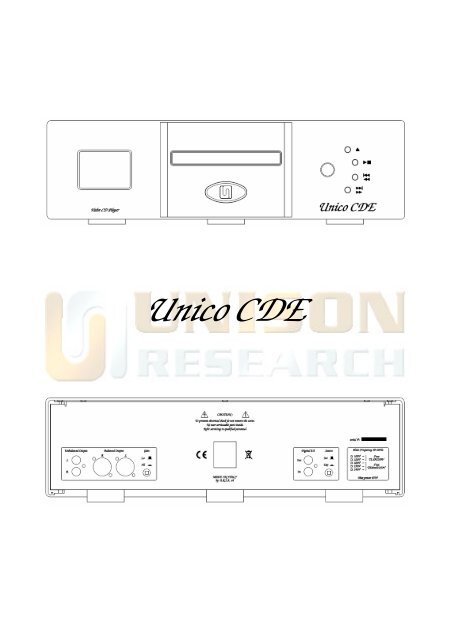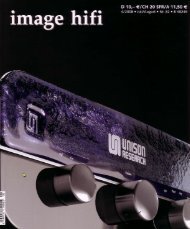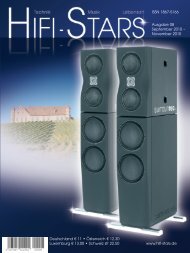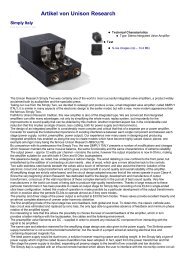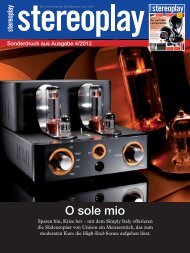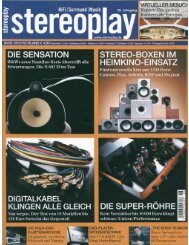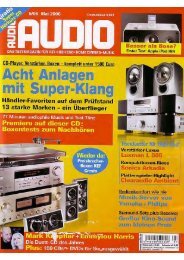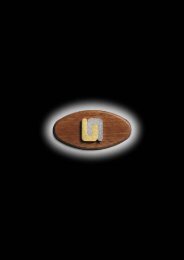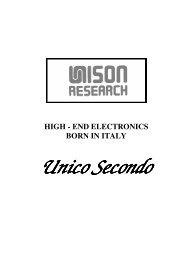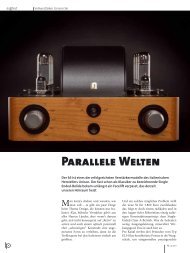Create successful ePaper yourself
Turn your PDF publications into a flip-book with our unique Google optimized e-Paper software.
The renewal of the top level products of <strong>Unico</strong> series begun with the new <strong>Unico</strong>100 integrated amplifier now<br />
reaches another major stage with the introduction of the <strong>Unico</strong> <strong>CDE</strong>.<br />
Once again <strong>Unison</strong> <strong>Research</strong> is firmly resolute to offer a device that deserve to be part of such a blazoned family, able<br />
to transmit tradition and bring innovation, able to change only to get better, with a look at the aesthetics but without<br />
forgetting the substance.<br />
Introduction<br />
Details<br />
The new <strong>Unico</strong><strong>CDE</strong> is the natural Evolution<br />
of the famous <strong>Unico</strong>CD, the world wide know CD<br />
player manufactured by <strong>Unison</strong> <strong>Research</strong>.<br />
As introduced with the <strong>Unico</strong> secondo the <strong>Unico</strong> <strong>CDE</strong><br />
too wears the black hairlined aluminium chassis. The<br />
extrusion sections as part of the project, designed by<br />
the <strong>Unison</strong> <strong>Research</strong> technical staff keeping in mind<br />
both aesthetic and functional features: rounded corners,<br />
housings for the fixing screws, the precise manufacture<br />
and assembly.<br />
The front panel clearly reveals how the new <strong>Unico</strong><br />
<strong>CDE</strong> belongs to the top level range of <strong>Unico</strong> series,<br />
leaded by the <strong>Unico</strong>200 and recently enriched by the<br />
<strong>Unico</strong>100. All the traditional features are preserved:<br />
the well known and beloved sandblasted and anodized<br />
aluminium front panel that defines the ”<strong>Unico</strong>-style”,<br />
the wooden logo inlay, the wide graphical display (an<br />
unique feature, almost exclusive for <strong>Unison</strong> <strong>Research</strong><br />
players) and that simple and user-friendly but complete<br />
interface.<br />
Once the top cover is removed the new <strong>Unico</strong><strong>CDE</strong><br />
shows lots of novelties. You cannot have a look at the<br />
audio output stage, easily identifiable thanks to the<br />
presence of the tubes, doubles if compared to the<br />
predecessor. Marshalled in a single row, symbolically<br />
splitting the “digital world” (the DAC converter) from<br />
the “analogue world” (the output connector and from<br />
there all the audio system till he user’s ears) there you<br />
can see four 12AX7/ECC83 double triodes. But as<br />
we’ll see further the valve character of the new device<br />
is in the circuit design more than in the number of<br />
components.<br />
Other interesting features will be discussed in details in<br />
the following lines.<br />
The brief introduction just seen offers only an<br />
overview of the device, let’s go in deep with the<br />
analysis of the new <strong>Unico</strong><strong>CDE</strong>.<br />
For the ones who know the <strong>Unico</strong> series<br />
products it will be easy to realize that a new aesthetics<br />
has been designed: the new <strong>Unico</strong><strong>CDE</strong> shows a new<br />
aluminium chassis. The choice of unsing this new<br />
design instead of the old painted iron chassis derives<br />
mostly from the will to take part of (and not to follow)<br />
the actual aesthetic trend, making easier to put our<br />
devices in a system using also other brands products.<br />
The front panel reveals the belonging of the new born<br />
CD player to the top level line of <strong>Unico</strong> series: heavy<br />
and sturdy, thick aluminium double panel, the same<br />
impeccable finishing by beadblasting (not<br />
sandblasting).<br />
Beadblasting is a surface finishing that consists in a<br />
surface cold hammering using an high pressure air flow<br />
bringing small ceramic bead, this gives to the surface<br />
an homogeneous, opaque look; the following<br />
anodization cause a film of aluminium oxide to grow<br />
on the surface giving more hardness and protection.<br />
The user interface is developed around a wide<br />
graphical display with 128x64 dot resolution where the<br />
software shows in a dynamic way all the information of<br />
the status on the disk. As in the <strong>Unico</strong>CD there’s an<br />
automatic brightness control that matches at any time<br />
the brightness of the display with the ambient light in<br />
order to censure the best view; in the <strong>Unico</strong><strong>CDE</strong> the<br />
user can switch off the back light of the LCD using the<br />
remote control, this will make the presence of the<br />
device much less intrusive during quite listening hours.<br />
All of the main functions can be accessed via the four<br />
push buttons on the front panel. The usage is now even<br />
easier thanks to a new developed software.<br />
A complete set of output connectors both XLR and<br />
RCA allows the user to connect the <strong>Unico</strong><strong>CDE</strong> to any<br />
other device, another pair of RCA connector are<br />
dedicated to a digital input/output interface. On the rear<br />
panel you’ll find a couple of micro switch that enable<br />
the digital source selection (internal, i.e. the CD drive,<br />
or external, according to the standard specified) and the<br />
gain of the audio stage (as we’ll see further).<br />
All of these news can be for someone enough<br />
to set on the shells a new device but as regards <strong>Unison</strong><br />
<strong>Research</strong> this is only the beginning.<br />
The internal layout is clear and neat, an iron<br />
screen shields both electromagnetic and mechanical<br />
noise and hides the mains connections and voltage
settings, the power transformer, the CD drive and most<br />
of the connecting cables.<br />
The power transformer is a thoroidal custom designed<br />
by <strong>Unison</strong> <strong>Research</strong>, low noise and over-sized (it can<br />
deliver up to 100VA, most of the time this is the power<br />
of a integrated amplifier transformer!).<br />
The CD drive has been selected among a lot of model<br />
of audio, general purpose, CD, DVD and CD burner;<br />
the keys of selection has been low-noise, reliability,<br />
easy of use and easy of service even in the future.<br />
The circuits of the <strong>Unico</strong><strong>CDE</strong> have been<br />
developed according to a modular structure: every PCB<br />
is dedicated to its function and every function has it’s<br />
own PCB. This way a minor cross-talk between power<br />
supply, control and audio stages can be achieved.<br />
The power supplies design inherits all the benefits<br />
tested in the preceding devices, here we have a series,<br />
8, of independent voltage regulator circuits. The use of<br />
independent heatsinks guarantees better performances<br />
and high reliability.<br />
All of the functions of the device are controlled by a<br />
microprocessor which runs a firmware developed in<br />
our laboratories.<br />
The S/PDIF signal sourced by the drive is fed to<br />
CRYSTAL CS8420 SCR circuit that perform an<br />
oversampling to 96kHz, bitter reduction and audio data<br />
control; the newly encoded digital data now goes to a<br />
CRYSTAL CS4392 digital-to-analogue converter that<br />
can process 24bit resolution data with a sampling<br />
frequency up to 192kHz.<br />
The design is intended to be fully and easily<br />
upgradeable, a still to come optional DAC board will<br />
be easy to install (just plug it). The dedicated software<br />
will allow the user to switch between the onboard DAC<br />
and the new one without switching off or opening the<br />
device, with the standard remote handset it will be very<br />
intuitive to navigate through an interactive menu and<br />
change the device settings.<br />
The audio stages are on a separated PCB away<br />
from the other circuits, this leave open all the<br />
possibilities for future upgrade and prevent the noise<br />
coming from other circuits to enter the audio stages.<br />
As seen before the new <strong>Unico</strong><strong>CDE</strong> has a completely<br />
new output audio stage; in all the other sources<br />
belonging to the <strong>Unico</strong> series the audio stage used to<br />
have the same structure: a tube gain stage (simpler in<br />
the <strong>Unico</strong>CDP, and more complex in <strong>Unico</strong>CD and<br />
<strong>Unico</strong>R) followed by a solid state transistor class A<br />
buffer. The design staff of <strong>Unison</strong> <strong>Research</strong> was sure<br />
that emphasizing the tube character of the device better<br />
sound result could be obtained so they bravely left the<br />
well tested solution for a brand new design. Since four<br />
different signals where needed (due to the balanced<br />
outputs) and a quite low output impedance was desired<br />
(in order to ensure correct performance with very other<br />
line amplifier in the chain) the output stage got to use<br />
not less than 8 triodes.<br />
Lots of listening tests has shown that the hazardous<br />
choice was a winning choice, giving the <strong>Unico</strong><strong>CDE</strong> an<br />
improved tone enhanced by the use of 12AX7/ECC83<br />
tubes instead of ECC82.<br />
Since the tube circuit is arranged as a parallel cathode<br />
follower there’s no voltage gain, so a preceding level<br />
booster has been added. It uses low noise audio<br />
operational amplifier to increase the level of the signal<br />
at the output of DA converter (leaving untouched the<br />
tube output stage and with it it’s distinctive sound<br />
performance), however this gain stage can be bypassed<br />
at any time via a rear push button. Combining the gain<br />
selection and the different output connectors different<br />
four levels can be obtained and the <strong>Unico</strong><strong>CDE</strong> can<br />
source the desired signal to any other component<br />
allowing the user to tune at the best it’s system.<br />
The care <strong>Unison</strong> <strong>Research</strong> puts in the design<br />
and production of its devices goes side-by-side with the<br />
attention dedicated to that elements only at a first<br />
glance negligible.<br />
The remote handset is a fine piece of artwork, with its<br />
wooden body covered by an aluminium plate, good<br />
looking and functional.<br />
The package ensure high grade protection to the device<br />
thanks to the anti-scratch fabric bag, the “stratocell” (a<br />
shock proof polyethylene foam much reliable than<br />
other common materials) shells and the double<br />
cardboard box.<br />
As seen in these few lines getting in contact<br />
with a <strong>Unison</strong> <strong>Research</strong> product is a very complex<br />
experience that goes further on that simply using an<br />
electronic device. Every piece manufactured by the<br />
Italian brand brings a fund of passion, refinement, care<br />
and experience that can be felt since the first moment,<br />
noticeable with the sight, touch and hearing.<br />
With the new <strong>Unico</strong><strong>CDE</strong> the <strong>Unison</strong> <strong>Research</strong> wants<br />
to offer to all the good music lovers the chance to<br />
experience any time pleasant moments.
Technical Characteristics<br />
Transport:<br />
TEAC CD5010A<br />
Digital Interface:<br />
D/A Converter:<br />
Conversion:<br />
Digital Input (Ext):<br />
Digital Output:<br />
Standard:<br />
CRYSTAL CS8420<br />
- reduced clock jitter<br />
- audio data correction<br />
CRYSTAL CS4392<br />
24bit/96kHz<br />
44.1kHz<br />
96kHz<br />
AES3, IEC60958 (S/PDIF)<br />
and EIAJ CP-1201<br />
Output stage:<br />
Valve complement:<br />
Gain Stage:<br />
Gain:<br />
Line outputs:<br />
Double Triode<br />
Parallel Cathode Follower<br />
4 x ECC83/12AX7<br />
Low Noise<br />
Audio Amplifier<br />
+0dB (Lo) / +9dB (Hi)<br />
1 RCA stereo<br />
1 XLR stereo<br />
Power consumption:<br />
Dimensions:<br />
Weight:<br />
100W max<br />
17.1in x 17in x 5.1in<br />
25lb


